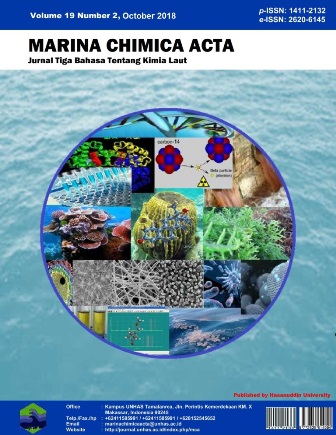ANALYSIS ACTIVITY 14C OF CORAL REEF IN KAYANGAN ISLAND
Abstract
The work is to determine absorption capacity, optimum time analysis, efficiency enumeration (TDCR), specific activityof 14C and coral age. Steps taken are physical and chemical washing, CO2 absorption, and analysis using liquid scintillation counter Hidex 300 SL. Due to washing, the weight loss was 4.74%. Total carbon absorbed was 1,056 grams. CO2 absorption capacity using KOH was 47% while optimum time analysis by LSC was 30 minutes and average efficiency enumeration (TDCR) was 0.6877. It was concluded that specific activityof 14C was 14.7361 DPM/gC and coral age in Kayangan Island was 310.49 years.References
Nurdin, A., Komatsu, T., Rani, C., Supriadi, Fakhriyyah, S., Agus, 2016, Coral Reef Destruction of Small Island in 44 Years and Destructive Fishing in Spermonde Archipelago, Indonesia, Earth Environ. Sci., doi:10.1088/1755-1315/47/1/012011.
Melawaty, L., Noor. A., Harlim, T., Voogd, N. D., 2014, Essential Metal Zn in Sponge Callyspongia aerizusa from Spermonde Archipelago, Advances in Biological Chemistry, 4:86-90.
Muller, E. M., Raymundo, L. J., Willis, B. L., et al., 2012, Coral Health and Disease in the Spermonde Archipelago and Wakatobi, Sulawesi, . J. Indonesia Coral Reef, 1(3): 147-159.
Kench, P. S. dan Mann, T., 2017, Reef Island Evolution and Dynamic: Insights from the Indian and Pacific Oceans and Perspectives for the Spermonde Archipelago, Frontiers in Marine Science, 4(145), doi: 10.3389/fmars.2017.00145.
Pandofili, J. M., 2011, Coral Reef: An Ecosystem in Transition, Springer Science, doi: 10.1007/978-94-007-0114-4_2
Chiu, T., Fairbanks, R. G., Mortlock, R. A., Cao, L., Fairbanks, T. W., Bloom, A. L., 2006, Redundant 230Th/234U/238U, 231Pa/235U and 14C Dating of Fossil Corals for Accurate Radiocarbon Age Calibration, Quatenary Science Review, 25, 2431-2440.
Mass, T., Giuffre, A. J., Sun, C., et al., 2017, Amorphous Calcium Carbonate Particles from Coral Skeletons, PNAS. doi: 10.1073/pnas.1707890114.
Polach, H. A., 1987, Evaluation and Status of Liquid Scintillation Counting for Radiocarbon Dating, Radiocarbon, 29(1): 1-11.
Owner’s Handbook Hidex 300 SL, 2010, Automatic Liquid Scintillation Counter, Hidex, Finland.
Horvatincic, N., Baresic, J., Bronic, I. K., Obelic, B., 2004, Measurement of Low 14C Activities in a Liquid scintillation Counter in The Zagreb Radiocarbon Laboratory, Radiocarbon, 46(1): 105-116.
L’Annunziata, M. F., 2012, Handbook of Radioactivity Analysis, Elsavier Inc., http://dx.doi.org/10.1016/B978-0-12-384873-4.00001-3.
Adkins, J. F., Griffin, S., Kashgarian, M., et. al., 2002, Radiocarbon Dating of Deep-Sea Corals, radiocarbon, 44(2): 567-580.
Hartoko, D. A., Noor, A., Zakir, M., and Maming, Utilization of Hydroxide Compound As CO2 Absorbent for Measurement of Carbon-14 in Coral Reef Sample From Spermonde Archipelago, Marina Chemica Acta, 17(2), ISSN 1411-2132.
Jauhari, and Maming, 2014, Determination of The Coral Age in Spermonde Archipelago Measurement 14C Activity Using LSC (Liquid Scintillation Counting) Method, Marina Chemica Acta, 15(1): 13-20.
Varlam, C., Stefanescu, I., Varlam, M., Popescu, I., Faurescu, I., 2007, Applying The Direct Absorption Method And LSC for 14C Concentration Measurement in Aqueous Samples, Radiocarbon, 49(2): 281-289.

